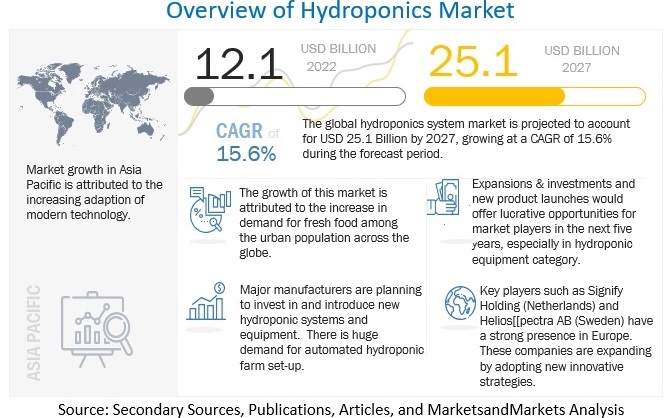
The global hydroponics market is experiencing a transformative wave, marked by significant advancements in technology and increasing awareness of sustainable agricultural practices. As we look towards 2027, the market is expected to continue its upward trajectory, driven by the demand for efficient, soil-less farming systems that offer higher yields and more control over crop production. This blog delves into the various facets of the hydroponics market, providing a comprehensive overview of its segments, including type, equipment, inputs, crop type, farming method, crop area, and region.
Download PDF brochure: https://www.marketsandmarkets.com/pdfdownloadNew.asp?id=94055021
Market Segmentation by Type
Aggregate Systems
Aggregate systems, such as the Wick, Ebb and Flow, and Drip systems, use a solid medium to support plant roots. These systems are popular due to their simplicity and cost-effectiveness. The growth medium in these systems can range from inert materials like perlite, vermiculite, and gravel to more organic options like coconut coir. Aggregate systems are particularly favored in regions where water scarcity is a concern, as they often require less water than traditional soil-based agriculture.
Liquid Systems
Liquid systems, including Nutrient Film Technique (NFT), Deep Water Culture (DWC), and Aeroponics, suspend plant roots directly in a nutrient-rich solution. These systems are known for their efficiency and high yields, as they provide plants with constant access to nutrients and oxygen. Liquid systems are gaining popularity in urban farming environments and vertical farms, where space optimization is crucial.
Equipment
The hydroponics market encompasses a range of equipment necessary for successful operation. Key equipment includes:
- Grow Lights: Essential for indoor farming, providing the necessary light spectrum for photosynthesis.
- Pumps and Tubes: Critical for nutrient delivery and water circulation in both aggregate and liquid systems.
- Climate Control Systems: Including HVAC systems, CO2 systems, and humidifiers/dehumidifiers, ensuring optimal growing conditions.
- Monitoring and Control Systems: Automated systems that manage nutrient levels, pH balance, and environmental conditions, enhancing precision and efficiency.
Inputs
Nutrients
Nutrient solutions are the lifeblood of hydroponic systems, providing essential minerals and elements required for plant growth. These solutions are carefully formulated to meet the specific needs of different crops, ensuring optimal growth and yield.
Grow Media
Grow media such as Rockwool, coconut coir, perlite, and peat moss provide support and a stable environment for root development. The choice of grow media can significantly impact water retention, aeration, and nutrient availability.
Crop Type
Vegetables
Leafy greens like lettuce, spinach, and kale dominate the hydroponic vegetable market, thanks to their short growth cycles and high market demand. Tomatoes, cucumbers, and peppers are also popular, benefiting from controlled environment agriculture that mitigates issues like pests and diseases.
Fruits
Strawberries and blueberries are the leading hydroponically grown fruits, prized for their high market value and the ability to produce high-quality, pesticide-free yields year-round.
Flowers
Ornamental plants and flowers, including roses and orchids, are increasingly being grown hydroponically to meet the demand for high-quality, aesthetically pleasing plants in the floriculture market.
Farming Method
Indoor
Indoor hydroponic farming, encompassing greenhouses and vertical farms, allows for year-round production regardless of external weather conditions. This method is particularly popular in urban areas where land is scarce, offering a solution for local, fresh produce supply.
Outdoor
Outdoor hydroponic systems, though less common, are used in regions with favorable climates. They can offer cost savings by utilizing natural sunlight while still providing the benefits of controlled nutrient delivery and efficient water use.
Crop Area
The scale of hydroponic operations can range from small-scale home systems to large commercial farms. Urban farming initiatives often utilize smaller areas with intensive vertical farming techniques, while rural operations may have larger horizontal setups.
Regional Insights
North America
North America, particularly the United States and Canada, leads the hydroponics market growth with significant investments in technology and infrastructure. The region’s focus on sustainable and locally sourced produce drives market growth.
Europe
Europe is another major player, with countries like the Netherlands and Germany at the forefront of hydroponic research and development. The region’s stringent regulations on pesticide use and emphasis on organic produce support the adoption of hydroponics.
Asia-Pacific
The Asia-Pacific region is witnessing rapid growth, driven by increasing urbanization, population growth, and the need for sustainable agricultural practices. China, Japan, and Australia are key markets within this region.
Latin America and Middle East & Africa
These regions are emerging markets for hydroponics, with increasing awareness and adoption of innovative farming techniques to address food security and water scarcity issues.
Speak to Analyst: https://www.marketsandmarkets.com/speaktoanalystNew.asp?id=94055021
Market Forecast to 2027
The global hydroponics market is projected to continue its robust growth through 2027, driven by technological advancements, rising consumer demand for fresh and locally grown produce, and the increasing need for sustainable agricultural practices. As the industry evolves, we can expect further innovations in automation, climate control, and nutrient delivery systems, enhancing efficiency and profitability for growers worldwide.
In conclusion, the hydroponics market is poised for significant expansion, offering a viable solution to some of the most pressing challenges in modern agriculture. By embracing these advanced farming techniques, we can look forward to a future of more sustainable, efficient, and productive food systems.